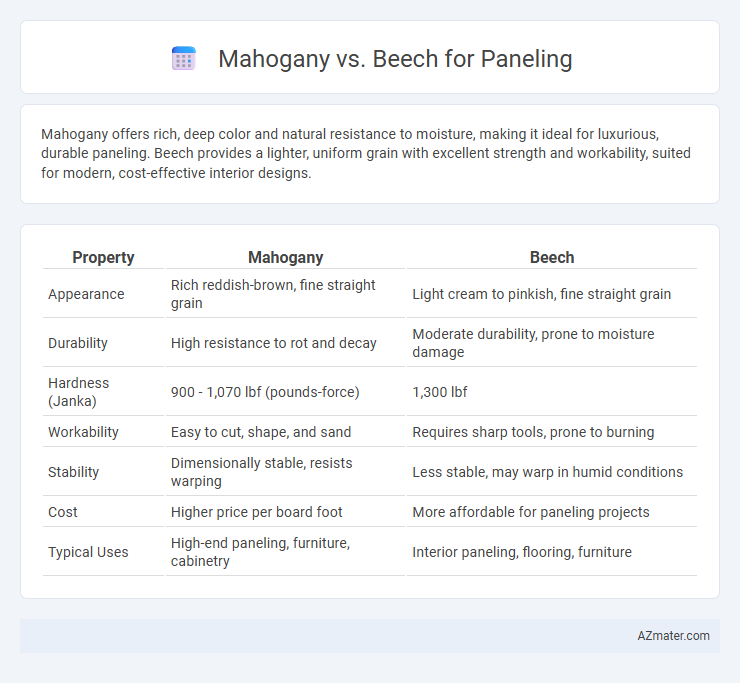Mahogany offers rich, deep color and natural resistance to moisture, making it ideal for luxurious, durable paneling. Beech provides a lighter, uniform grain with excellent strength and workability, suited for modern, cost-effective interior designs.
Table of Comparison
| Property | Mahogany | Beech |
|---|---|---|
| Appearance | Rich reddish-brown, fine straight grain | Light cream to pinkish, fine straight grain |
| Durability | High resistance to rot and decay | Moderate durability, prone to moisture damage |
| Hardness (Janka) | 900 - 1,070 lbf (pounds-force) | 1,300 lbf |
| Workability | Easy to cut, shape, and sand | Requires sharp tools, prone to burning |
| Stability | Dimensionally stable, resists warping | Less stable, may warp in humid conditions |
| Cost | Higher price per board foot | More affordable for paneling projects |
| Typical Uses | High-end paneling, furniture, cabinetry | Interior paneling, flooring, furniture |
Introduction to Wood Paneling Choices
Mahogany and Beech are popular wood paneling choices valued for their durability and aesthetic appeal. Mahogany offers rich, deep reddish-brown tones with excellent resistance to decay, making it ideal for luxurious, long-lasting interiors. Beech features a lighter, creamy color with a smooth, fine grain, favored for its strength and affordability in contemporary paneling designs.
Mahogany: Overview and Characteristics
Mahogany is prized for its rich, reddish-brown color, fine grain, and exceptional durability, making it a top choice for high-end paneling. This hardwood offers excellent resistance to decay and warping, ensuring long-lasting, elegant interior surfaces. Its natural oils and dense grain provide a smooth finish that enhances aesthetic appeal and maintains strength over time.
Beech: Overview and Characteristics
Beech wood is renowned for its light color, smooth grain, and exceptional hardness, making it a durable choice for paneling that resists dents and scratches. Its uniform texture and fine pores allow for excellent staining and finishing, enhancing aesthetic versatility in interior designs. Compared to mahogany, beech offers a more sustainable and cost-effective option while maintaining strong structural properties ideal for high-traffic areas.
Aesthetic Appeal: Mahogany vs Beech
Mahogany offers a rich, deep reddish-brown color with a smooth, fine grain that exudes luxury and warmth, making it a popular choice for upscale paneling. Beech, conversely, features a lighter, creamy tone with a more uniform, subtle grain that provides a clean and modern aesthetic ideal for bright, minimalist spaces. The choice between mahogany and beech for paneling ultimately hinges on whether the desired look leans toward classic elegance or contemporary simplicity.
Durability and Longevity Comparison
Mahogany offers superior durability and exceptional resistance to rot and insect damage, making it ideal for high-traffic or humid environments in paneling applications. Beech, while also strong and hard, is more susceptible to moisture-related issues and requires better maintenance to prevent warping and decay over time. Both woods provide longevity, but mahogany's natural oils and dense grain structure grant it a longer lifespan in demanding conditions.
Cost Analysis: Mahogany vs Beech
Mahogany paneling typically costs between $10 to $25 per square foot due to its premium durability and rich coloration, making it a higher-end choice compared to Beech. Beech paneling averages $5 to $12 per square foot, offering a budget-friendly option with good strength but less resistance to moisture than Mahogany. Comparing long-term investment, Mahogany's longevity and aesthetic appeal may justify its higher initial cost in high-end interior designs, while Beech suits cost-sensitive projects prioritizing functionality.
Workability and Installation Ease
Mahogany offers excellent workability due to its fine, straight grain, allowing for smooth cutting, shaping, and finishing, making it ideal for detailed paneling projects. Beech, while also workable, tends to be harder and denser, which can increase the effort needed during installation and finishing stages. The ease of installation for mahogany panels typically surpasses beech because its softness reduces the risk of splintering and improves fastening reliability.
Maintenance Requirements
Mahogany paneling demands moderate maintenance, requiring regular dusting and occasional polishing to preserve its rich, reddish-brown hue and prevent surface dulling. Beech paneling offers easier upkeep due to its lighter color and fine grain, needing only routine cleaning and periodic sealing to protect against moisture and wear. Both woods benefit from avoiding excessive humidity and direct sunlight to maintain their integrity and appearance over time.
Environmental Impact and Sustainability
Mahogany paneling is less sustainable due to its slow growth rate and high demand, often leading to deforestation in tropical regions. Beech, sourced primarily from managed European forests, offers a more renewable option with faster growth cycles and better forest management certifications like FSC. Choosing beech over mahogany reduces environmental impact by promoting sustainable forestry and minimizing habitat destruction.
Conclusion: Which Wood is Best for Paneling?
Mahogany offers superior durability, rich color, and natural resistance to moisture, making it an excellent choice for high-end paneling in humid environments. Beech provides a lighter, more affordable option with good strength and a smooth grain pattern, suitable for modern, minimalist designs. Choosing between mahogany and beech depends on budget, desired aesthetics, and environmental factors, with mahogany favored for premium finishes and beech preferred for cost-effective, versatile applications.

Infographic: Mahogany vs Beech for Paneling
 azmater.com
azmater.com